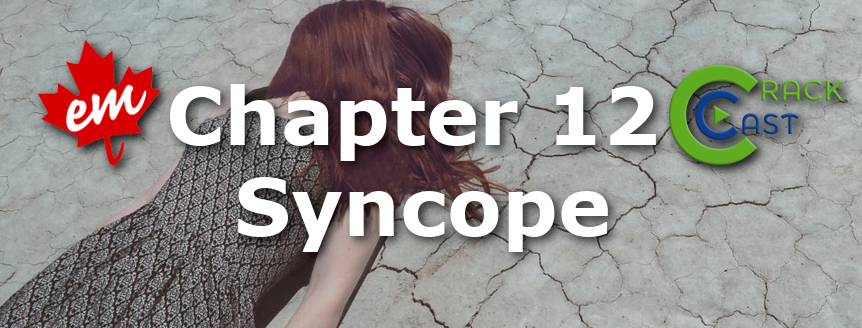Syncope is one of the core presentations we see in the ED. While benign for many patients, there are several critical diagnoses we need to rule out in the syncopal patient. This episode features Chloe Labrie, a Family Medicine Resident with a keen interest in EM.
Shownotes: PDF Here
Core Questions:
[bg_faq_start]Rosen’s in Perspective
Syncope is a “sudden transient loss of consciousness with a loss of postural tone,” typically with an immediate return to baseline afterwards. This is a common ED presentation. Causes are typically benign, however there are some killers that can hide in these presentations. History, physical and ECG are your key diagnostic modalities.
The final common pathway resulting in syncope is bilateral cortical dysfunction and/or brainstem dysfunction (esp reticular activating system, secondary to hypoperfusion. Loss of consciousness causes the loss of postural tone and bam, syncope. Less severe hypoperfusion can cause feelings of presyncope, which we consider to be on the same continuum of disease.
There are 3 major classifications of syncope: vasovagal, orthostatic hypotension, and cardiovascular. Other general causes and mimics include seizures, hypoglycemia, toxins, metabolic derangements, hyperventilation, psychiatric causes, and some primary neurologic conditions.
[1] List 10 life-threatening causes of syncope
- Myocardial infarction
- Dysrhythmias
- Thoracic aortic dissection
- Critical aortic stenosis
- Hypertrophic cardiomyopathy
- Pericardial tamponade
- Abdominal aortic aneurysm
- Massive pulmonary embolism
- Subarachnoid hemorrhage
- Stroke (cerebrovascular accident)
- Toxic-metabolic derangements
- Severe hypovolemia or hemorrhage
- Ruptured ectopic pregnancy
- Sepsis
(Adapted from Box 12.3, Rosen’s 9th Ed.)
[2] List 10 medications that can precipitate syncope
In true CRACKCast fashion, there are way more than 10 (See Box 12.2 in Rosen’s 9th Edition).
- Cardiovascular agents
- Beta blockers
- Vasodilators—beta blockers, calcium channel blockers, nitrates, hydralazine, angiotensin-converting enzyme inhibitors, angiotensin receptor blockers, phenothiazines, phosphodiesterase inhibitors
- Diuretics
- Central antihypertensives (eg, clonidine, methyldopa)
- Other antihypertensives (eg, guanethidine)
- QT-prolonging agents (eg, amiodarone, disopyramide, flecainide, procainamide, quinidine, sotalol)
- Other antidysrhythmics
- Psychoactive agents
- Anticonvulsants (eg, carbamazepine, phenytoin)
- Antiparkinsonian agents
- Central nervous system depressants (eg, barbiturates, benzodiazepines)
- Monoamine oxidase inhibitors
- Antidepressants
- Narcotic analgesics
- Sedating and nonsedating antihistamines
- Cholinesterase inhibitors (eg, donepezil, tacrine, galantamine)
- Drugs with other mechanisms
- Drugs of abuse (eg, cannabis, cocaine, alcohol, heroin)
- Digitalis
- Insulin and oral hypoglycemics
- Neuropathic agents (vincristine)
- Nonsteroidal antiinflammatory drugs
- Bromocriptine
3] What are the red flags on history and physical exam in syncope?
History
- Event:
- Preceded by chest pain/Headache/abdo pain
- Sudden onset with no warning/prodrome. Conversely, look for that vasovagal prodrome or inciting event (eg postmicturition)
- Exertional syncope
- GI bleeding
- Associated PV bleeding or cramping in female of childbearing age
- Dyspnea, hemoptysis
- Features that would suggest a mimic (eg postictal phase, tongue bite)
- Fevers, chills, other infectious symptoms
- PMHx/Meds:
- VTE risk factors
- Meds that can precipitate syncope (also look at recent changes – esp. Diuretics, beta blockers, antihypertensives)
Exam
Vitals – pay close attention (HR too fast, slow, hypoxia, hypotension etc)
Neuro – LOC, lateralizing deficits
Cardiac/Resp – murmurs, pulses (unequal in dissection, subclavian steal), volume status
Abdominal/Rectal/GU (if concern for bleeding, tenderness etc)
[4] What are 5 ECG findings to look for in the syncopal patient?
- Dysrhythmias
- Pre-excitation
- Shortened PR
- Prolonged QTc
- ST Elevation (regional and diffuse)
- Brugada pattern (RBBB in association with ST elevation in V1-V3)
- Right ventricular strain pattern
- Electrical alternans
[5] What are markers of increased short-term risk in syncope patients? See Box 12.4
The following list is adapted from Box 12.4 in Rosen’s 9th Edition.
- Age >65 years
- Male gender
- History of CHF
- History of CVD or serious dysrhythmia
- History of structural heart disease
- Family history of early (<50 years) sudden death
- Syncope without prodrome
- Exertional syncope
- Dyspnea or shortness of breath
- Syncope during supine position
- Hypotension – systolic BP <90 mmHg
- Abnormal EKG
- Anemia with HCT <30% or hemoglobin <90 g/L
[6] List five indications for admission and inpatient evaluation for the patient with syncope?
According to Rosen’s 9th Edition, the following are indications for admission and inpatient evaluation of patients with syncope:
- Presence of chest pain
- Dyspnea or SOB that is unexplained
- History of CHF
- History of significant valvular disease
- Patients with electrocardiographic evidence of ventricular dysrhythmias,ischemia, significant QT prolongation, or new bundle branch block
Potentially consider prolonged monitoring for patients with:
- Age > 65 years
- Pre-existing cardiovascular or congenital heart disease
- Family history of sudden death
- Serious comorbidities (e.g., diabetes mellitus)
- Exertional syncope
Wisecracks:
[1] What is the significance of a patient presenting with syncope vs. near syncope?
This is a question we have all asked ourselves at one time or another. We so often have patients who complain about a vague history of lightheadedness on review of systems, and for many emergency clinicians, complaints of presyncope are often seen as being less worrisome. However, some new research suggests that presyncope is JUST AS SIGNIFICANT as complaints of syncope.
Study: Bastani A et al. Comparison of 30-Day Serious Adverse Clinical Events for Elderly Patients Presenting to the Emergency Department with Near-Syncope Versus Syncope. Ann Emerg Med 2018. PMID: 30529112
Design: Prospective observational study
Outcomes:
- Primary Outcome
- Incidence of 30-day death or serious clinical events
Results:
- Syncope Group
- 18.2% mortality or serious clinical events
- Presyncope Group
- 18.7% mortality or serious clinical events
Clinical Predictors of Serious Outcomes
- Dyspnea
- Abnormal EKG
- History of Dysrhythmia
- Physician Risk Assessment (i.e., gestalt)
For more nuanced FOAMed evaluation of this article, check out REBEL EM’s post here: https://rebelem.com/30-day-outcomes-in-syncope-vs-near-syncope/
[2] What is the utility of orthostatic vital signs?
We all know that orthostatic vitals to assess a patient’s fluid status are not necessarily useful. However, according to Rosen’s 9th Edition, orthostatic vitals could add valuable evidence to your diagnostic work up.
New evidence, however, suggests this is not the case. In a critical appraisal by Schaffer et al. published in the Journal of Emergency Medicine in 2018 (https://www.ncbi.nlm.nih.gov/pubmed/30316621) show that orthostatic changes in the emergency department do not reliably diagnose or exclude orthostatic syncope. Additionally, orthostatic vitals do not help to exclude the existence of a potentially serious or life threatening cause of a patient’s syncope.
[3] What degree of cerebral hypoperfusion is needed to cause unconsciousness?
Quick little tidbit to help you impress your attending on your next ED shift:
- Hypoperfusion resulting in a reduction of cerebral blood flow by >/35% will reliably results in unconsciousness
- This hypoperfusion can be the result of changes in CO, SVR, blood volume, regional systemic vascular resistance




